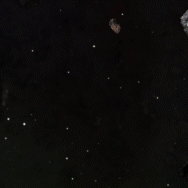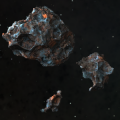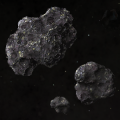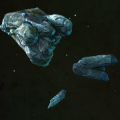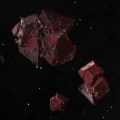Asteroids
| This article is a stub, and not comprehensive. |
|---|
| You can help this wiki by expanding it. |
![]() Space Age expansion exclusive feature.
Space Age expansion exclusive feature.
Asteroids are floating minerals found in space. There are four types of asteroids in Space Age: metallic, carbon, oxide and promethium. Promethium asteroids are only encountered at the Shattered Planet. Asteroids are immediately seen when the player is present at a space platform. If a space station is being boosted through space with a thruster, asteroids are encountered much faster. When an asteroid collector is present at a space station, small asteroid chunks can be collected for its chunks of resources. The resources collected from asteroid chunks can be fed into a crusher, grinding the chunks into useful resources.
When traveling through space, the space platform can enter a dangerous asteroid field, where many asteroids can hit the player's platform and destroy it. This means that turrets with well-stocked ammunition and asteroid collectors should be properly placed around a platform to ward off the asteroids.
The density of asteroids can be seen by going to the Remote View > Surfaces > Space Map and alt-clicking on the interplanetary route to bring up the route in Factoriopedia, or by searching "route". The graph will show a white vertical line overlay on the asteroid graph corresponding to the ship's position when underway.
Asteroid Types
| Name | Description | Health | Resistances |
|---|---|---|---|
| Asteroid Chunks | Can be grabbed by the collectors. Do no damage upon contact with the space platform.
Do not have health and are instantly destroyed on contact with the space platform. |
N/A | N/A |
| Small Asteroids | Do not spawn naturally. Produce chunks on destruction.
Do small damage on contact with the space platform. |
100 |
|
| Medium Asteroids | Spawn in space and in orbit af planets other than Nauvis. Split into small asteroids when destroyed.
Do medium damage. Can destroy several foundations before expiring. |
400 |
|
| Big Asteroids | Spawn in space beyond Fulgora. Split into medium asteroids when destroyed.
Do large amount of damage. Can go right through the space platform destroying everything on its path. |
2000 |
|
| Huge Asteroids | Spawn in space beyond Aquilo. Split into large asteroids when destroyed.
Will absolutely destroy the space platform if it is not equipped with a turret |
5000 |
|
Asteroid Chunks
Asteroid chunks are the smallest asteroids in the game, serving as the sole resource source in space. Due to their size and low mass, these small chunks will not damage the player's space platform when colliding with it, as larger asteroids do. To maintain sustainability, space platforms should be equipped with both asteroid collector and crusher. These chunks come in four distinct varieties, each of which can be processed into valuable materials using crushers. Advanced asteroid processing research unlocks the ability to extract additional materials from these chunks.
| Asteroids | Processed Into | Advanced Processing |
|---|---|---|
| Metallic asteroid chunk |
iron ore | copper ore |
| Carbonic asteroid chunk |
carbon |
sulfur |
| Oxide asteroid chunk |
ice |
calcite |
| Promethium asteroid chunk |
cannot be processed, is a component to the promethium science pack |
- |
